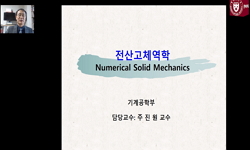The presence of residual stresses (RS) in a material causes a shift of the indentation load-displacement curve. The resulting change in the Kick's law coefficient C can hence be exploited to estimate these RS. By contrast with axisymmetric indenters, ...
http://chineseinput.net/에서 pinyin(병음)방식으로 중국어를 변환할 수 있습니다.
변환된 중국어를 복사하여 사용하시면 됩니다.
- 中文 을 입력하시려면 zhongwen을 입력하시고 space를누르시면됩니다.
- 北京 을 입력하시려면 beijing을 입력하시고 space를 누르시면 됩니다.


A contact size-independent approach to the estimation of biaxial residual stresses by Knoop indentation
한글로보기https://www.riss.kr/link?id=A107515034
- 저자
- 발행기관
- 학술지명
- 권호사항
-
발행연도
2015
-
작성언어
-
- 주제어
-
등재정보
SCOPUS,SCIE
-
자료형태
학술저널
-
수록면
300-312(13쪽)
- 제공처
-
0
상세조회 -
0
다운로드
부가정보
다국어 초록 (Multilingual Abstract)
The presence of residual stresses (RS) in a material causes a shift of the indentation load-displacement curve. The resulting change in the Kick's law coefficient C can hence be exploited to estimate these RS. By contrast with axisymmetric indenters, when employing the Knoop indenter with its large aspect-ratio, C is further sensitive to the indenter's orientation with respect to the principal RS directions. For a wide range of material properties, maximum and minimum C values are obtained by finite element analysis. It is observed that the RS ratio can be estimated directly from the C ratio, independent of magnitude and sign of RS. Further, the finding that C values for the non-equibiaxial RS case can be converted to equivalent C values for two equibiaxial RS cases, made for conical indentation (J.H. Lee et al., 2010, J Mater Res 25: 2212-2223), is shown to apply to Knoop indentation, too. The magnitude of RS can thus be determined from the equibiaxial RS case. The equibiaxial RS case is investigated in detail and mapping functions are established between C and the corresponding RS value. Finally the method is validated experimentally by comparison with Knoop indentation of bended cross-shaped steel specimens.
동일학술지(권/호) 다른 논문
-
Notch effect on creep damage for Hastelloy C276-BNi2 brazing joint
- Scientific and Technical Press ; Elsevier Science Ltd
- Luo, Y.
- 2015
- SCOPUS,SCIE
-
Tribological properties of twin wire arc spray coated aluminum cylinder liner
- Scientific and Technical Press ; Elsevier Science Ltd
- Kim, J.K.
- 2015
- SCOPUS,SCIE




 ScienceON
ScienceON






